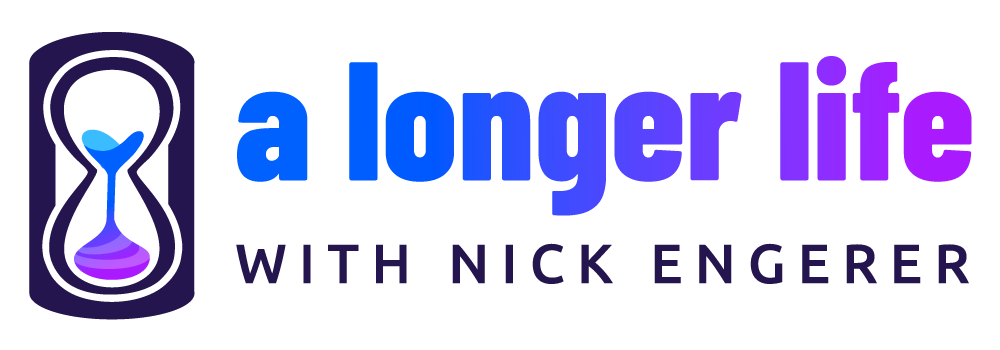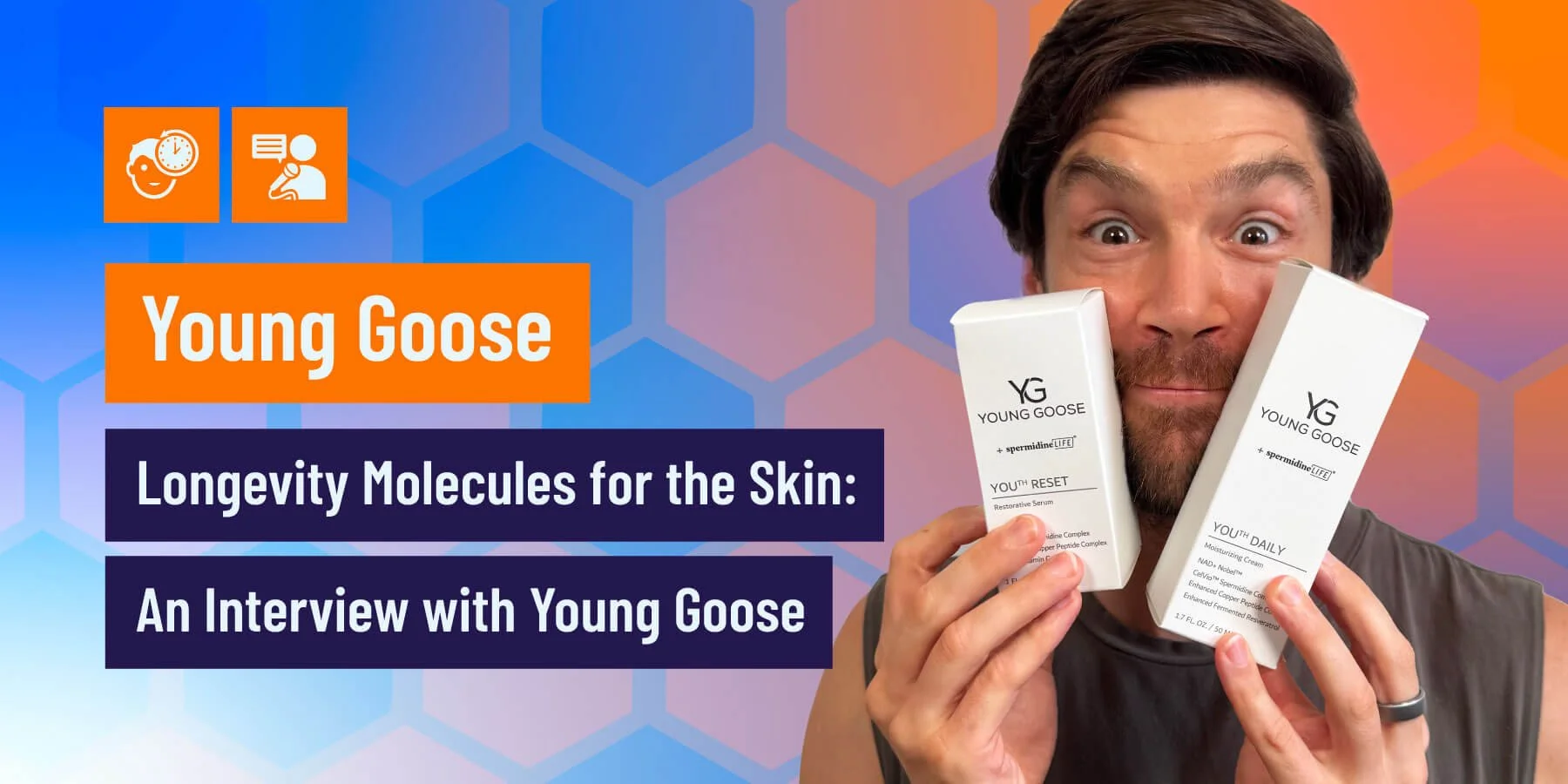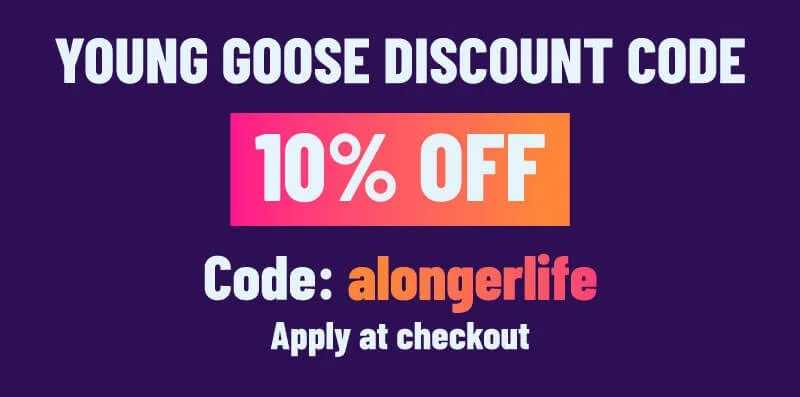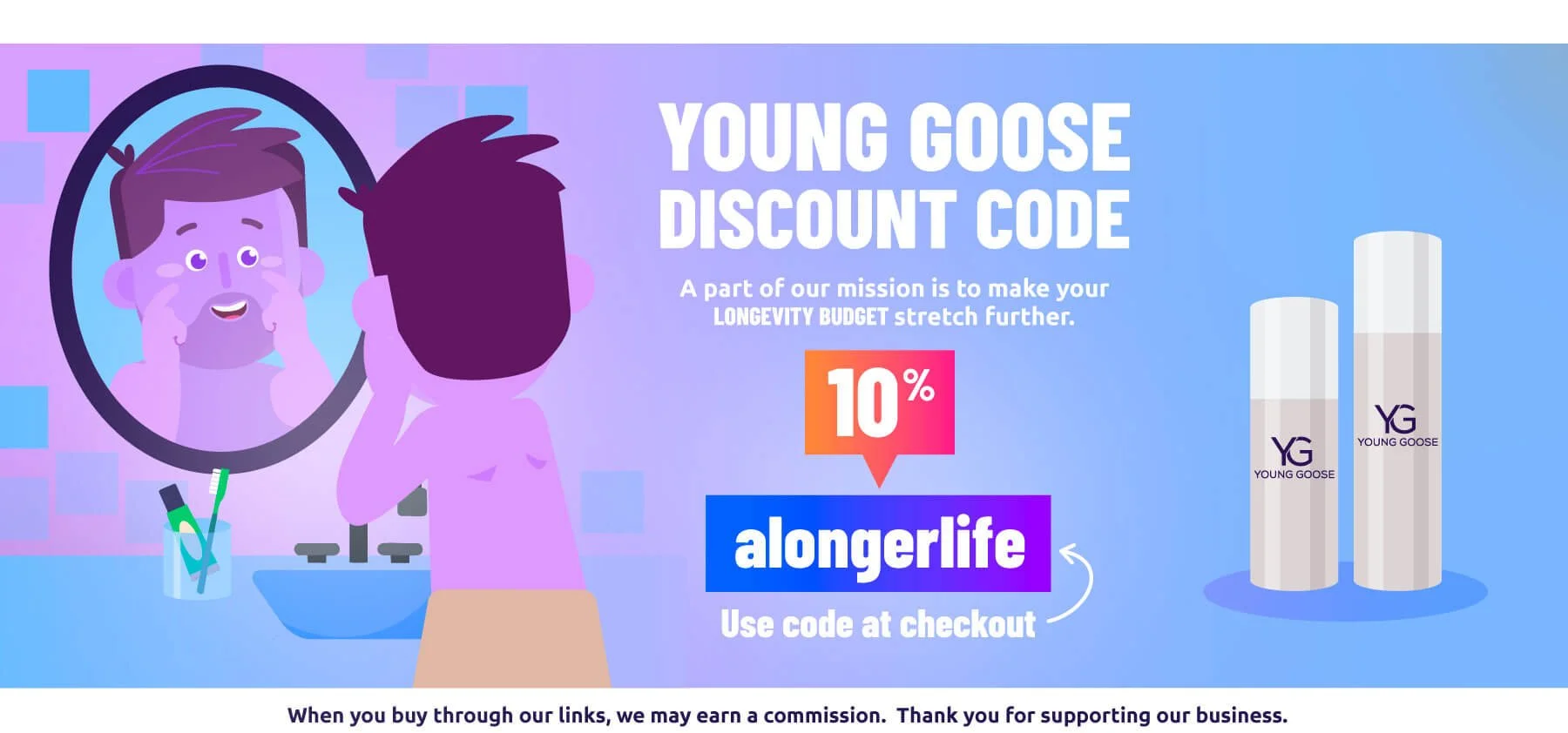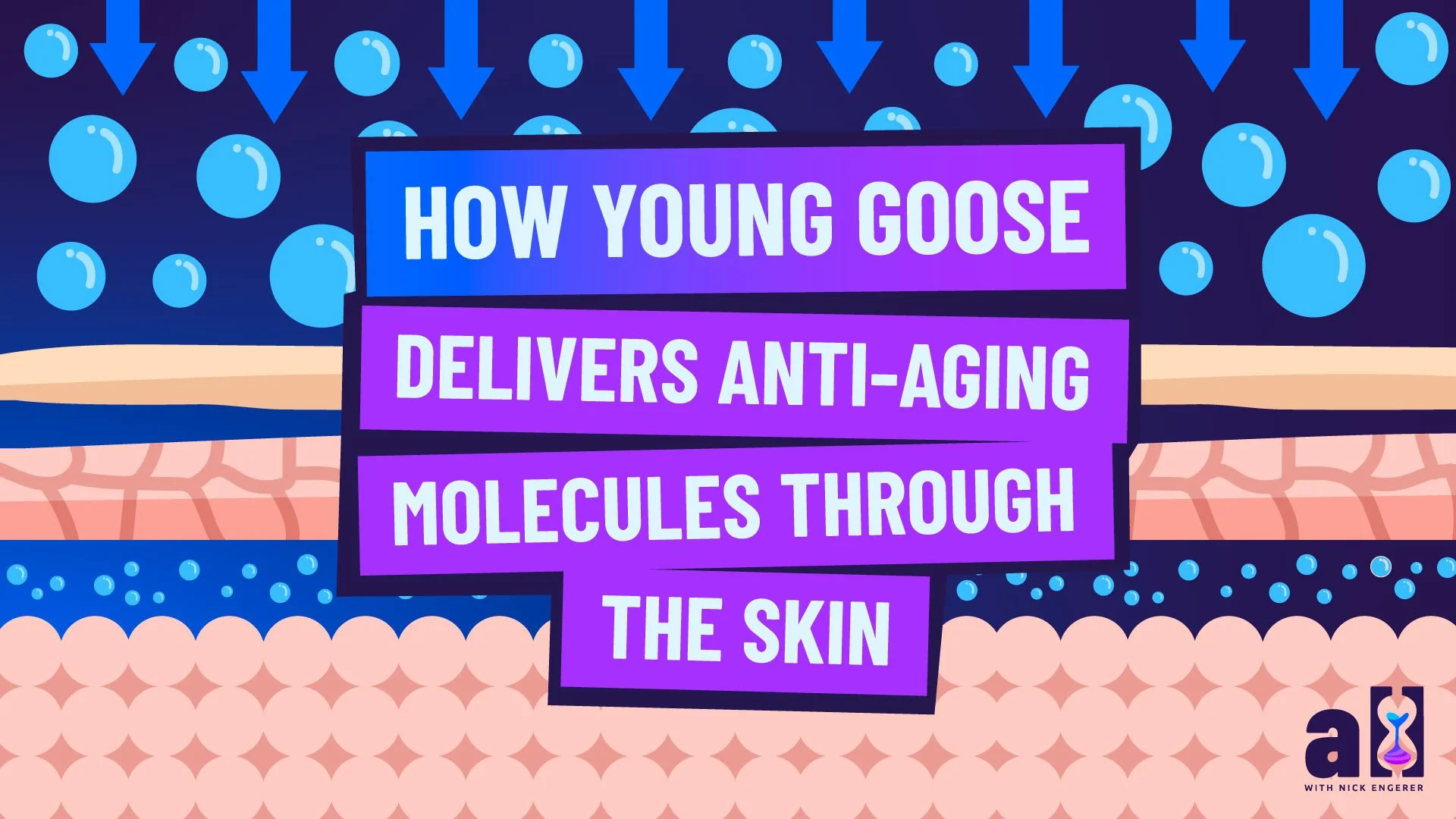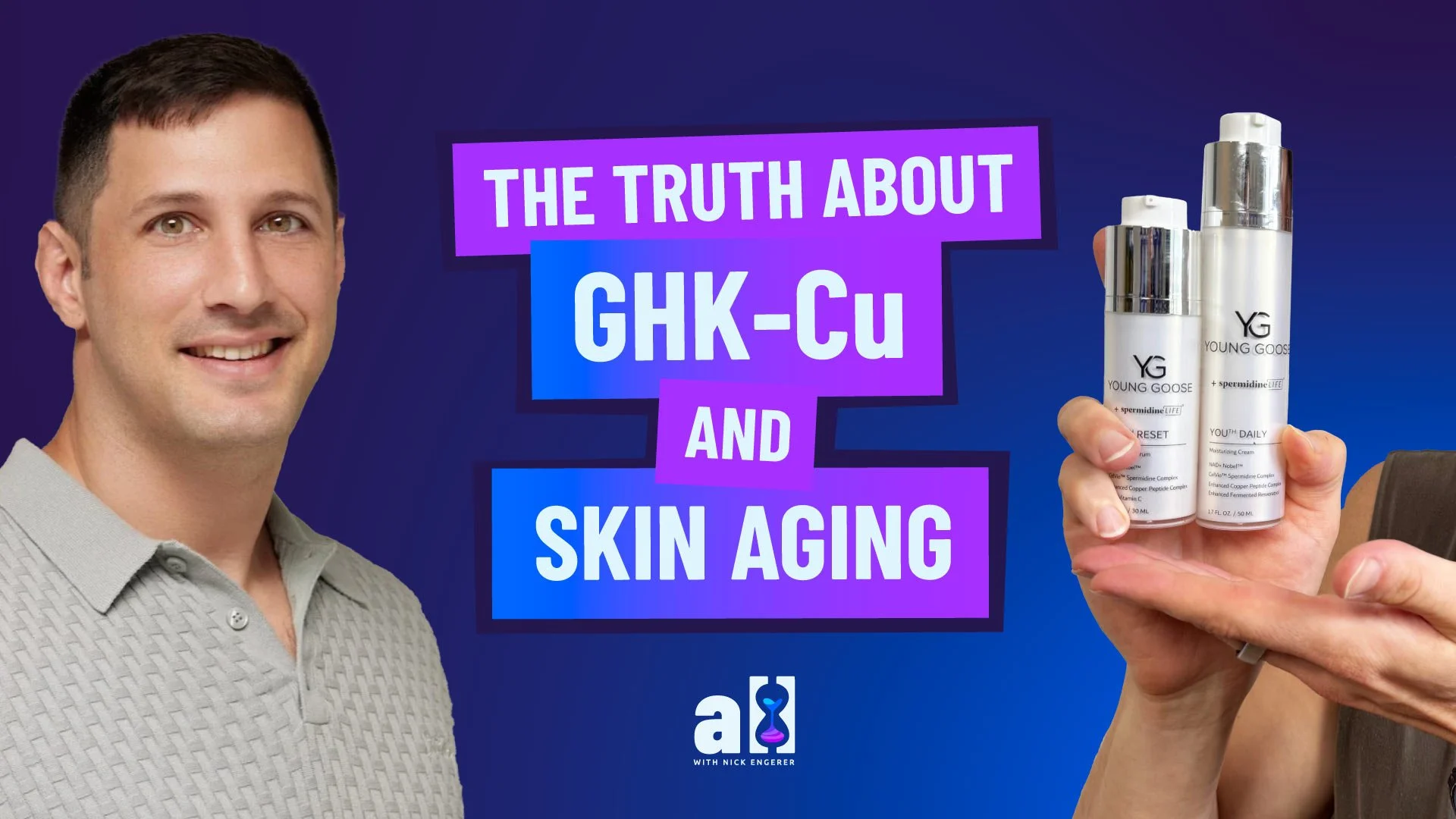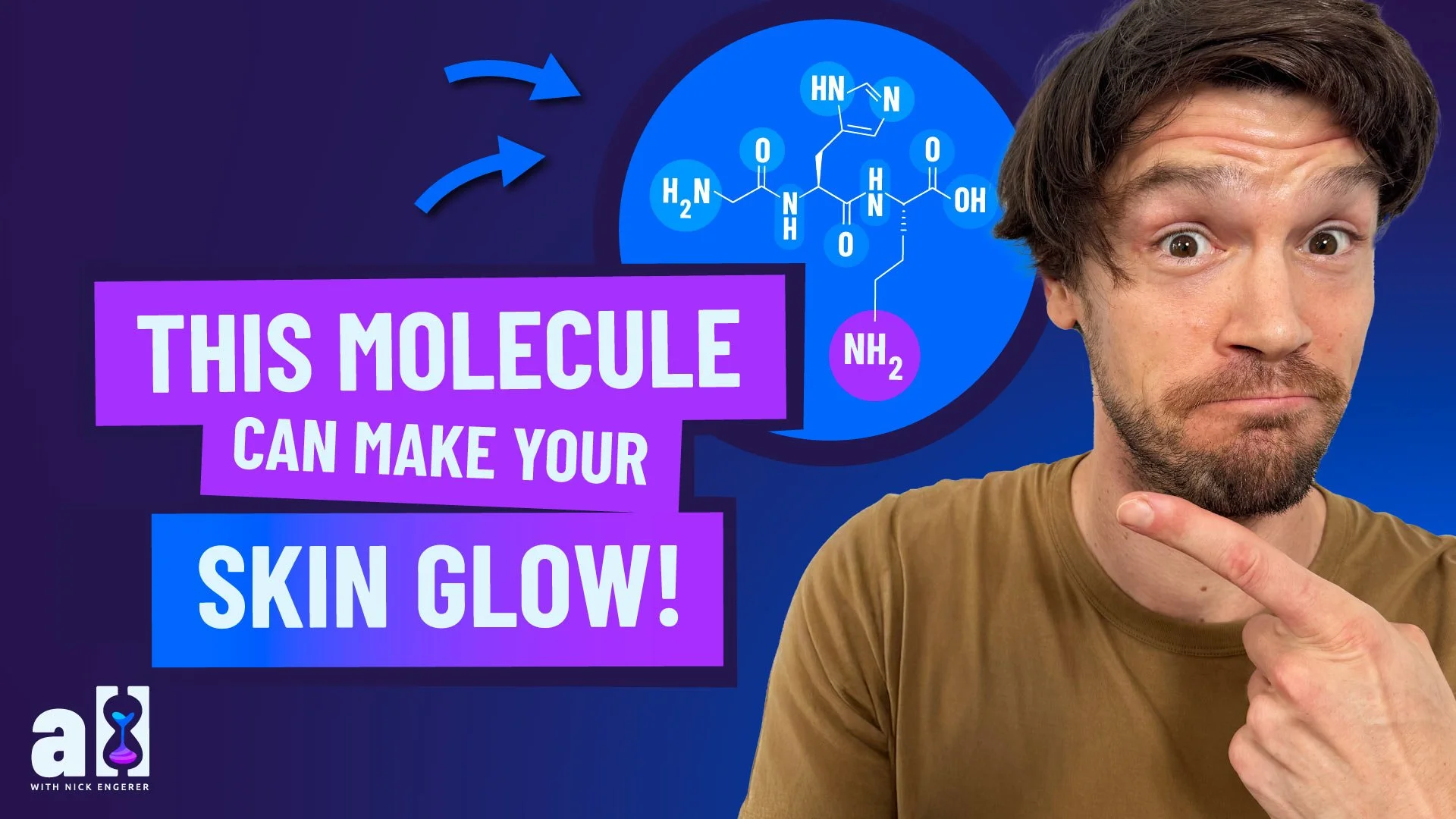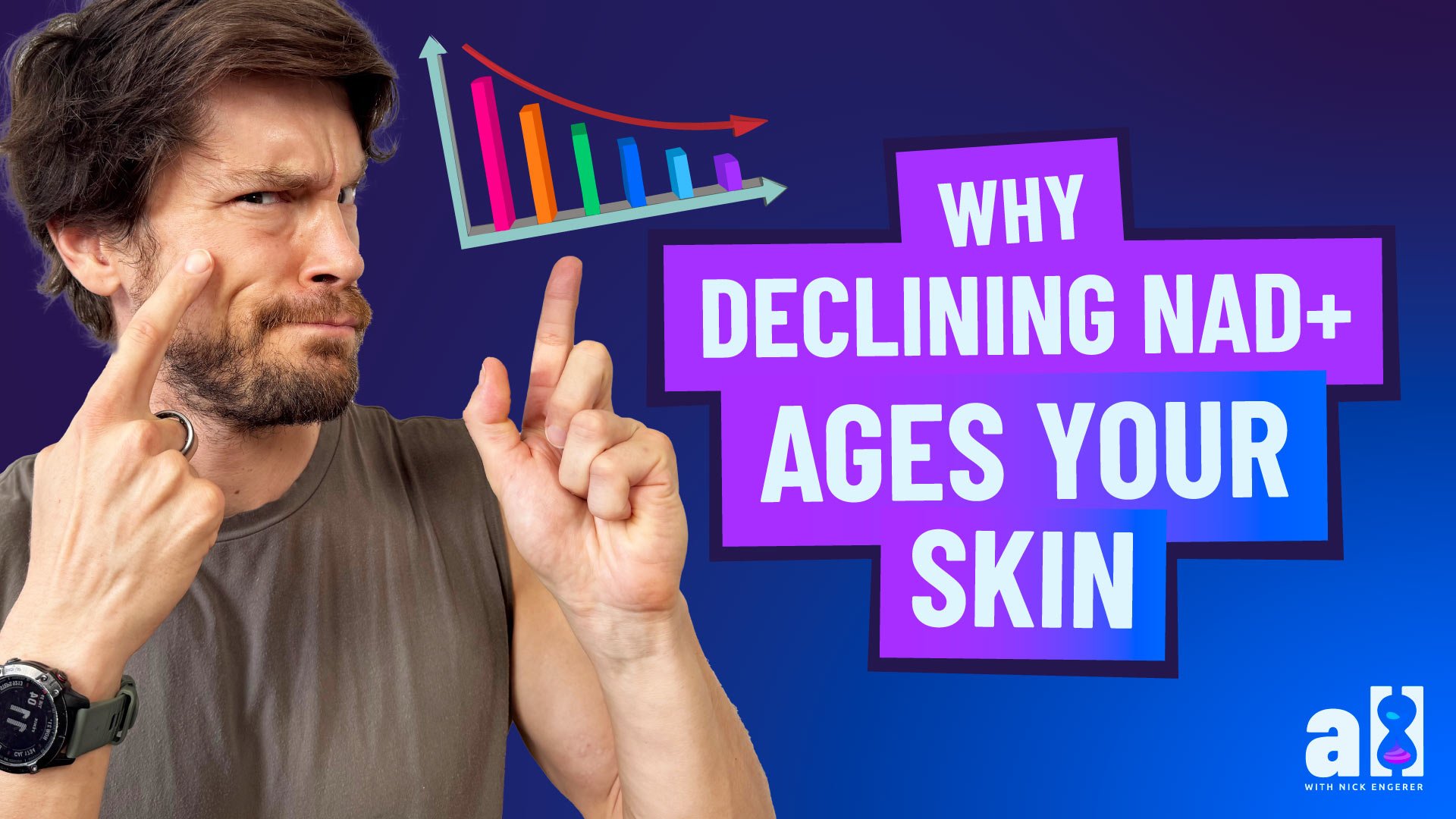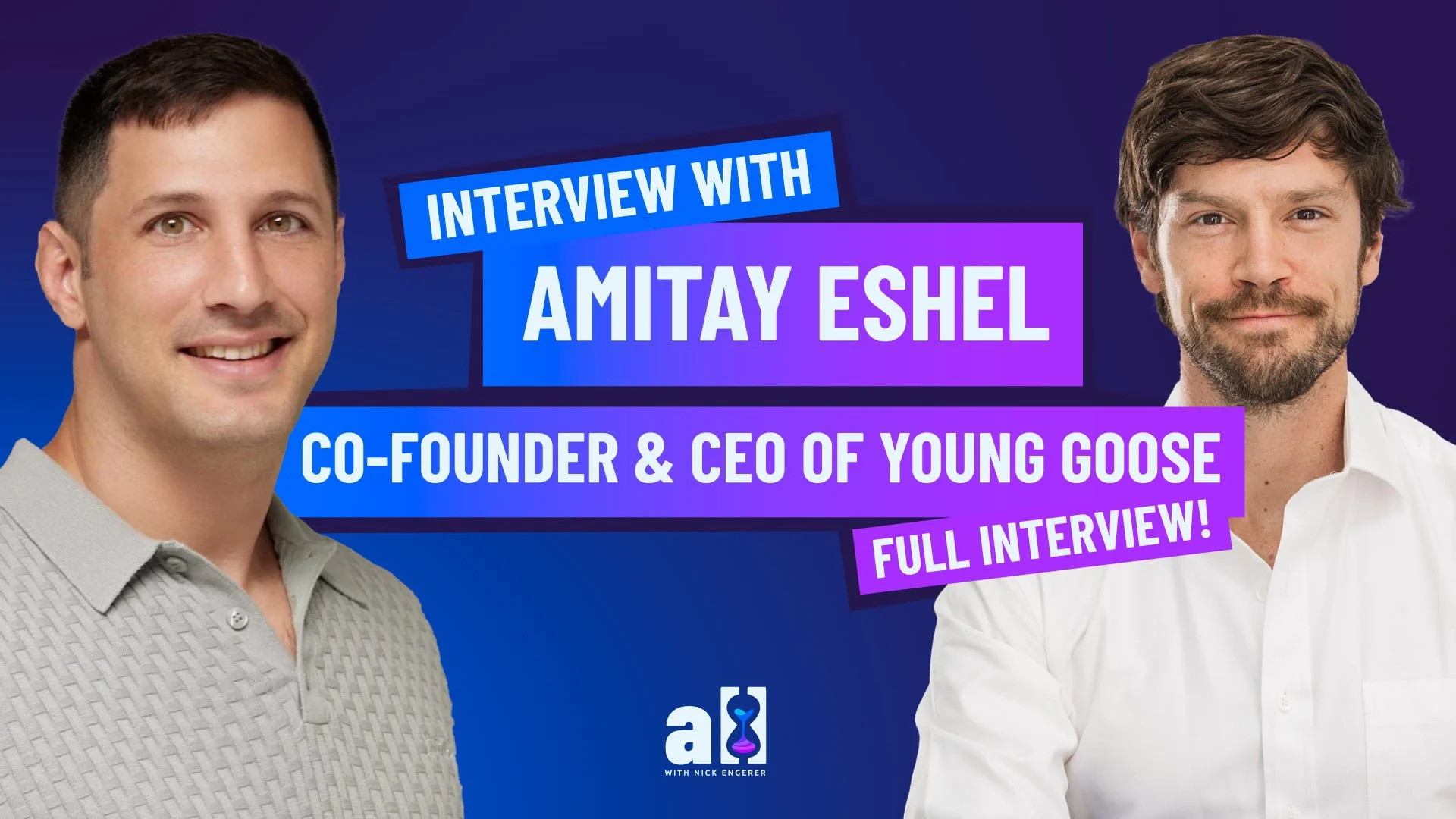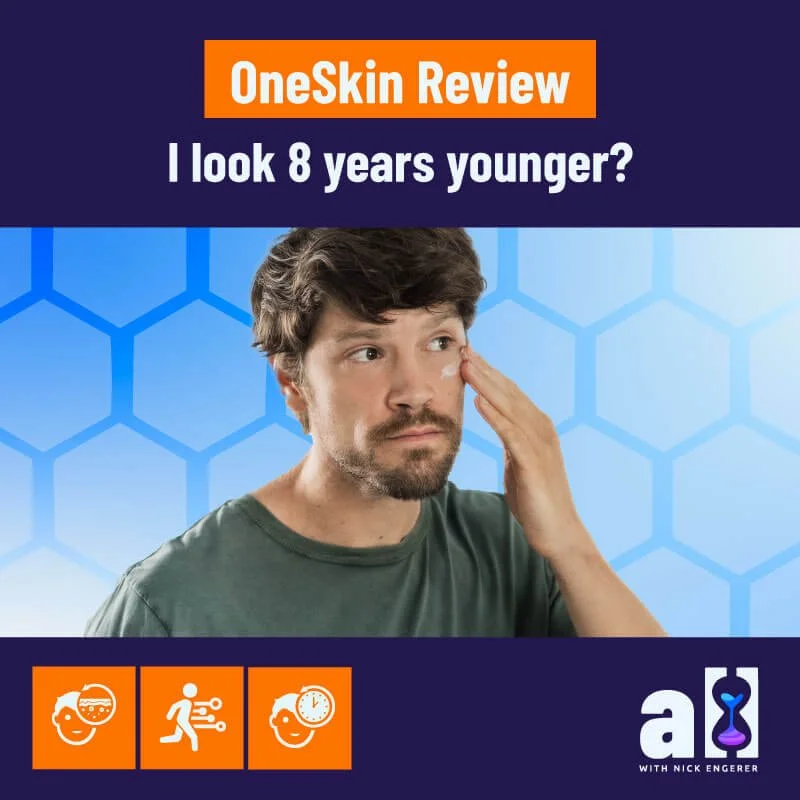The Longevity Molecules Behind Young Goose Skincare
The Quest to Deliver Longevity Molecules to Your Skin
Can Young Goose Skincare really deliver well known longevity molecules into your skin?
It is a bold claim on their part, given the challenges at hand. But as we discovered in our 1:1 interview with CEO and Co-Founder of Young Goose Amitay Eshel, they’ve done the hard work to overcome them.
For readers of A Longer Life, your quite familiar with our position on skincare. It is about far more than vanity - your aesthetic age (how old you look) is an asset to be invested in and protected. But perhaps more importantly, your skin is the on the frontline of the aging process itself. Warding off damage from environmental stressors and dangers of UV radiation, many of the age-related processes which cause you to “look” older, as actually the same as those which make you biologically older, directly.
As many in the longevity movement already know, there are many, relatively new ‘longevity molecules’ which can assist us in warding off the aging process. At this stage, at best, they can help to slow things down, but as our interviewee will suggest, it is completely possible that you can ‘wind back the clock’ on your skin’s biological age.
Can Longevity Molecules Make it Into the Skin?
However, these ‘longevity molecules’ can not be simply applied topically to the skin, where we hope for the best on the other side. Most are too large or even too unstable to last on the shelf/in the mail on their way to you from the production line.
This is why Young Goose first set off on their mission to answer this key question:
“Can we effectively deliver longevity molecules through the skin?”
Fascinatingly, through years of effort, trial and error and following all of the latest science, Young Goose were able to find ways to deliver several key longevity molecules in a useable format, into your skin cells. These include spermidine, NAD+, resveratrol, and copper peptides.
Through this work, they found that not only was it a “Yes”, they can do so, but that in fact:
“Our skin actually craves these molecules to facilitate its own repair”
In our conversation, Amitay delves into the complexities of spermidine (including what it has to do with sperm?!), NAD+ and its delivery mechanisms in skincare, the role of copper peptides and resveratrol, and practical tips for self-experimentation in skincare routines.
 |
We also discuss the importance of understanding the science behind skincare ingredients and how to effectively measure impact on skin health. In closing, Amitay shares insights on the latest advancements in skincare technology and emphasizes the significance of community and lifestyle choices in promoting longevity.
Let’s get straight into the discussion which we have broken down for you into key segments with the most important and relevant information, followed at the end by the full interview, should you want to dive into all of the nitty gritty details!
Skin Longevity:
Can Molecules Like Spermidine Make it into Skin Cells?
A Longer Life (ALL):
I'm joined today by Amitay Eshel, the Co-founder and CEO of Young Goose.
Let’s start with something I found really compelling. Inside your product packaging, there's a thought provoking question:
"Can we effectively deliver longevity molecules through the skin?"
It’s a smart question, entrepreneurial and scientifically deep. And I love how you framed the answer: “that our skin actually craves these molecules to support its own repair processes”.
Let’s unpack that question first: Can we effectively deliver longevity molecules through the skin
Amitay Eshel:
There are a couple of important prerequisites for that. First, we have to respect the laws of physics, specifically the molecular weight of the ingredient. In other words, the size of the molecule determines whether it can penetrate the skin barrier.
We’re not talking about weight like you’d measure on a scale, this is about molecular structure and size. For a molecule to be absorbed through the skin, it needs to be small enough to pass through pores or be transported through other pathways like into hair follicles, or in some cases, even into the bloodstream.
There are a few ways we can enhance this delivery. For example, we can use chemical agents like glycolic acid, which can dissolve the bonds between skin cells. Or we can use micro-injury techniques, like creating micro-channels in the skin, what’s often done in microneedling to enhance penetration. But those methods are more invasive, and not typically what we rely on for everyday use.
At Young Goose, we focus on more conventional and skin-friendly methods for delivering longevity molecules like NAD precursors, spermidine, peptides, and resveratrol.
So to recap, effective delivery depends on three key things:
Molecular size—the ingredient must be small enough to penetrate.
A proper delivery system—this helps the molecule cross the skin’s lipid barrier.
Accurate formulation—we must ensure the product actually contains the active ingredient in a bioavailable form.
How Young Goose’s Copper Peptides Boost Skin Youthfulness
ALL:
It’s great to have your wealth of knowledge, your honesty, and your awareness of where the state-of-the-art is, because this field is complex and evolving rapidly. As our listeners can hear, it’s getting harder and harder to understand what really differentiates certain products or ingredients in the longevity space.
That’s exactly the space I want to explore today.
Now, we could easily spend more time diving into NAD+, but I want to use something you just mentioned as a natural segway. You brought up copper and peptides, which leads us perfectly into a fascinating topic: copper peptides.
Your products feature an Enhanced Copper Peptide Complex, and I want to unpack that for a moment.
Amitay Eshel:
Most people are familiar with GHK-Cu, which is the traditional form of copper peptide. It’s known for stimulating collagen synthesis, enhancing wound healing, and is often where scientific research starts when testing skin-active ingredients. GHK-Cu also shows promising anti-aging effects from increasing hyaluronic acid production to boosting elastin levels.
Personally, I consider elastin even more important than collagen when it comes to skin appearance. Collagen gives the skin firmness, but elastin gives it flexibility. That flexibility is key to how youthful skin moves and behaves.
What we do at Young Goose is augment GHK-Cu with additional synergistic peptides. These are specifically designed to amplify extracellular matrix (ECM) production which includes elastin fibers and other structural components of the skin.
We also include neuropeptides that help with something really interesting, they slightly reduce the skin's tendency to fold or bend in the exact same spot, over and over. That gives the newly built scaffolding collagen, elastin, and other ECM components a better chance to stay intact over time.
Imagine you’re trying to build a house, but there are constant earthquakes. If those quakes always hit the same exact spot, it’s going to be much harder to make progress. But if the tremors happen around your site, not directly on it, you might lose a few bricks, but the structure will have a better chance of surviving.
That’s essentially what we’re doing, improving the statistical survival of newly produced collagen and elastin by minimizing repetitive stress in the same facial areas. When you combine that with copper peptides like GHK-Cu, the result is a much more effective way to support skin longevity.
Why Fermented Resveratrol Powers Young Goose
ALL:
What’s the role of resveratrol when it comes to the skin, and what does it mean when we talk about fermented resveratrol?
Amitay Eshel:
Resveratrol, in the context of skincare, is first and foremost a polyphenol. It’s known for reducing inflammation and oxidative stress, essentially acting as both an antioxidant and an anti-inflammatory agent.
In the world of longevity, it's hard to affect a complex system like the entire human body with a single molecule. But when applied topically, resveratrol can have significant effects, sometimes too significant. It can actually be overly stimulatory, even toxic, if not used properly. That’s where fermentation becomes essential.
Fermentation essentially pre-digests the molecule, mimicking the enzyme activity our skin doesn't naturally have. Unlike our gut, which has trouble absorbing resveratrol due to fat interference, the skin has no enzyme at all to break it down. So unfermented resveratrol is not only poorly bioavailable, but it can also build up and cause toxicity when applied repeatedly.
Fermentation solves both of these problems. It makes resveratrol:
50x more bioavailable
Non-toxic, even with repeated use
Able to support other longevity molecules like NAD+ and spermidine more effectively
On its own, resveratrol might have mild antioxidant effects. But when it’s fermented and combined with other longevity pathways, it becomes a powerful tool for improving skin health and resilience.
ALL:
I’ve read a lot about resveratrol, but I wasn’t aware of the fermentation step and how critical it is to improving bioavailability in the skin.
Spermidine in Young Goose: Youthful Skin Through Autophagy
ALL:
On the front of your product box, there’s a list of very interesting ingredients that most people might not recognize. One of them is spermidine and we’ve done some homework on this. Are we right in thinking you were the first to bring spermidine to the skincare market?
Amitay Eshel:
Yes, that’s correct.
ALL:
In terms of its role in counteracting the decline of youthful function, spermidine seems to be connected to activating cellular autophagy. So before we dive into the science, let's address the elephant in the room:
What does it actually have to do with sperm?
Amitay Eshel:
Spermidine was discovered by Antonie Van Leeuwenhoek, the inventor of the microscope. Being a curious guy with a microscope... well, you can imagine where that led. He observed crystal-like structures in his own semen, and that’s where the molecule got its name. But importantly: no sperm is involved in modern production of spermidine. No sperm is harmed. We can now derive it ethically and synthetically.
ALL:
Good to know! Tell us more about the science: what is spermidine’s role in autophagy, and why does that matter for skin?
Amitay Eshel:
You can also experience the benefits of spermidine for healthier skin through oral supplementation - along with other clinically established benefits like improved cardiovascular health, brain function and ‘cellular defense mechanisms’.
Autophagy literally means “self-eating”, it is the body’s way of cleaning the house. Imagine your cells are a city, like New York or Sydney. The city functions well, but it creates waste. If no one picks up the trash, the city breaks down. That’s what happens at the cellular level when autophagy stops functioning often because the cells become senescent.
Spermidine re-activates autophagy. It helps the body identify damaged or malfunctioning components and eliminates them. While people often say "recycling," the better term is elimination, getting rid of what’s no longer useful.
In the skin, this process leads to:
Reduced signs of aging
Improved texture and resilience
Enhanced regeneration
More youthful cellular function overall
And that’s why we believe spermidine is such an exciting longevity molecule in skincare.
The Powerful Rejuvenating Effects of Spermidine for Your Skin
ALL:
What does spermidine actually do to our skin that we can see in the mirror?
Amitay Eshel:
Beyond science, what matters most is what you can see and feel in your skin. With spermidine, we’ve been able to measure significant changes using visual imaging systems. With regular use, users report and we observe:
Improved skin firmness and elasticity
Smoother skin texture
Significant reduction in fine lines
A very unique benefit: enhanced radiance
That glow or radiance is driven primarily by autophagic clearance. When your skin cells are clearing out damaged components more efficiently, they renew faster, and the overall cellular turnover improves. That’s the mechanism behind what looks like more youthful, more vibrant skin.
NAD+ Nobel: Powering Youthful Skin with Advanced Delivery
ALL:
When NAD+ levels decline as we age, that decline compromises all the NAD+-dependent processes. These are critical for cellular energy production, DNA repair, and overall cell function. So when NAD+ goes down, skin aging accelerates. We're talking wrinkles, reduced elasticity, uneven pigmentation, and diminished radiance.
Amitay:
That’s why NAD+ is so vital for maintaining youthful skin function. A lot of people have heard of Nicotinamide Riboside (NR) and Nicotinamide Mononucleotide (NMN) popular NAD+ boosters. And there's been ongoing debate about which of these molecules actually gets into the cell.
But more importantly, we asked: How can we get NAD+ into the skin itself? That’s where NAD+ Nobel came into our original patented complex. It uses a special in-situ breakdown process. Basically, we break NAD+ into its precursors NR, NMN, and others using ultrasonic vibration, reducing them to tiny, nano-sized molecules.
These molecules are then suspended in a lipid-based gel, creating microencapsulated bubbles that are liposomal so they’re stable, absorbable, and they actually reach the skin cells. Think of it as targeted NAD+ delivery to support skin longevity.
We’re now rolling out an upgraded version called NAD Apex, but NAD+ Nobel laid the foundation.
Personalizing Your Young Goose Skincare Routine with the Routine Finder
ALL:
For anyone who’s interested in building a full skincare routine with Young Goose products, I saw you’ve created something called the Routine Finder on your website. What’s that all about?
Amitay Eshel:
It’s our Routine Finder Quiz. It’s designed to help people build a personalized skincare protocol. You answer a few quick questions, and it gives you a tailored plan. We built it with the biohacking community in mind because let’s be honest, a lot of people in our world think, “If one product is good, then ten must be better.”
But that’s not always the case, especially when you’re dealing with powerful longevity ingredients. So we guide people through tiers of product use, starting slow and cautious if they want, or going all-in if they prefer.
Eventually, we’re also planning to offer a metabolomic test. A blood test that can help you optimize your skincare routine even more precisely. That’s going to take a while to roll out, and it’ll be a premium offering, but it’s coming.
ALL:
For someone who completes the Routine Finder and gets their protocol, how long should they give it before evaluating results, and how can they best track their progress?
Amitay Eshel:
First off, you want to make sure you’re taking before-and-after photos properly. That means the same place, same time of day, same lighting. Natural light is best, but if you’re using artificial light, like a ring light, just keep it consistent.
Give it 4 to 6 weeks to see real changes.
And here’s a simple but powerful test, especially for people over 40, The Pinch Test. Take an area like the back of your hand. Pinch the skin and see how long it takes to bounce back.
Before starting your routine, document that bounce-back time either by video or note. Then, do it again after 6 weeks. You’ll likely see that the skin rebounds faster that’s a sign of improved elastin fiber function.
You can even do it by squinting hard or smiling, videotaping how fast your skin returns to baseline. It’s a fun and surprisingly effective way to track skin resilience.
Tracking Young Goose Skincare Results with Hormonal Precision
ALL:
I want to discuss something really important, especially for women tracking their skincare results with tools like the Visia scan. What should they know?
Amitay Eshel:
This is something we touched on before, and it’s really key: if you’re menstruating, your skin changes throughout your cycle. Estrogen levels rise and fall, and that affects things like collagen and elastin so your skin might appear more radiant, plumper, or even firmer at certain times.
Meanwhile, progesterone can have hydrating effects for some women, but for others, it may cause clogged pores. So depending on when in your cycle you do a Visia scan, you might get very different results, even if your skincare hasn’t changed. That’s because the Visia is measuring visible, not cellular, changes.
ALL:
That’s huge, cycle timing matters when tracking skincare outcomes visually.
Amitay:
It’s not just for menstruating women. If you're on hormone replacement therapy male or female, it matters too. For example, if you're using hormone pellets or creams, timing your Visia scan relative to your treatment cycle is important. Your skin is responding to those hormones, and you want to be comparing apples to apples.
ALL:
Self-experimenting is only helpful if it’s done with good controls. We want to know: “Is this product helping me?” And that only works when you’ve accounted for these hormonal variables.
Amitay:
Exactly. And that brings us to a bigger message: any longevity-focused skincare is a long-term investment. It's not about overnight miracles it’s about consistent inputs, done smartly, over time.
Nick:
I’d love to get your top 3 long-term skin health recommendations outside of high-tech products or serums. Just practical, science-backed basics.
Amitay Eshel:
Number one is light management.
When you're in the sun, use a mineral-based broad-spectrum sunscreen, and try to get sun exposure before 10 a.m. or after 4 p.m those are the lowest UV windows.
At home, limit exposure to artificial blue light, especially in the evening. And if you're in front of screens or under LEDs a lot, wear tinted sunscreen ours use iron oxides, which block blue light without being makeup.
Number two is prioritizing quality sleep and stress management.
Cortisol—your stress hormone—is a major skin-aging driver. You can literally see it in “before and after” photos of any U.S. President. Sleep and stress regulation help lower cortisol, improve recovery, and keep your skin youthful.
Tip Number 3 watch the full interview to find out!
Want to learn more? Watch the full interview
 |

